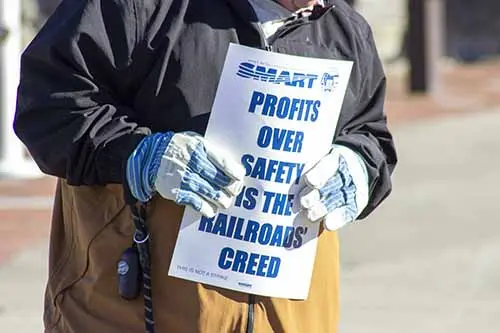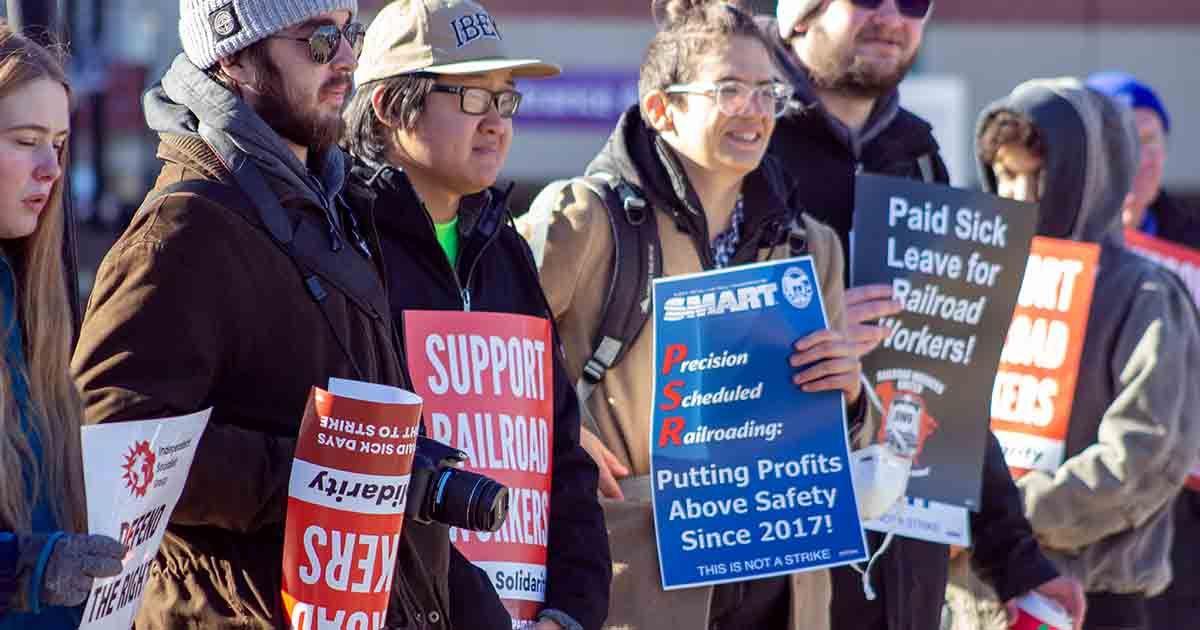WORCESTER – Around 50 rail workers held a standout on Tuesday on Foster Street in Worcester, organized by SMART Transportation Division local #898 and local #1473, with support from Railroad Workers United. The demonstration intended to bring awareness to the contract imposed by the federal government on freight rail workers earlier this month, and issues of public safety that workers say affect the national supply chain failures that impact inflation.
The rail workers at the demonstration highlighted a proposed regulation by the Federal Railroad Administration (FRA) to require most trains to be operated by not less than a two-person crew. FRA holds a public hearing on Wednesday in Washington D.C. on the proposed regulation.
Workers at the demonstration highlighted that the public has direct input on regulations via comments. They encourage member of the public to participate in public comments on the proposed regulation, which can be done online and without providing your name.
Rail Freight by Two-Person Crews
Nick Wurst, a freight rail conductor at CSX and Worcester resident, took part in Tuesday’s demonstration. He is a member of SMART Transportation Division, the largest of the twelve unions subject to the contract imposed by the federal government on freight rail workers Dec. 1. He also works with Railroad Workers United, an inter-union organization promoting unity across the different rail unions and job specialties.
Wurst told ThisWeekinWorcester.com that two-person crews are standard in cargo transport by rail across the US. For example, trains with 60 to 70 cars transporting ethnol frequently travel through Worcester. Those trains have a two-person crew operating them, like most in the freight rail industry.
Companies in the industry have sought to reduce that to only one individual, according to Wurst.
While it is in the interests of workers to preserve jobs by fighting against smaller crews, Wurst says single-person crews are a danger to public safety. Cargo volumes of 15,000 tons travel across rail the United States, often at high speeds, and can include dangerous or hazardous material.
Each two-person crew includes an engineer and a conductor. The engineer is responsible for operating the often massive vehicle, including managing speed, breaking and controlling what can be a machine with thousands of tons of cargo.
The conductor handles most other required responsibilities, including documentation, which can be substantial when dealing with hazardous materials. Some other responsibilities include communication with dispatchers and track authority, throwing switches, tying down railcars and other safety related aspects of the load.

Single-Person Crew Disaster
Wurst cited an example of the potential danger to public safety of single-person train crews. In 2013, a single person crew transporting crude oil by a 4,700 foot long series of train cars weighing 10,000 metric tons stopped in Lac-Mégantic, Quebec, Canada, after a 13-hour shift. The single operator failed to secure the train properly. While unattended, the cars and cargo rolled down an incline along the tracks and derailed in the downtown area of Lac-Mégantic. The resulting explosion caused 47 deaths and destroyed over 30 buildings. An additional 36 buildings required demolition due to petroleum contamination.
Wurst said a second person in that situation is a needed redundancy after a long shift of dangerous work. The responsibilities during travel are also unsafe to expect of one person.
The desire for single person crews is a continuation of what the industry calls “Precision Scheduled Railroading, ” which Wurst says has led to a rail system that is imprecise and rarely on schedule, The industry phrase, he says, is jargon that means “operating at the bare minimum.”
Reduction of Workers, Exploding Profits
Hunter Harrison, a railway executive who was CEO of several rail companies during his career, created precision schedule railroading (PSR). He was last CEO of CSX Corporation until his death in 2017.
PSR is defined as “a railroad strategy that uses departure schedules and point-to-point delivery methods to achieve low operating ratios and consolidate railroad networks.”
Operating ratio is the operating expense as a percentage of revenue. Cutting costs, increasing revenue, or a combination of both are the only means to lower operating ratios.
In April, US Surface Transportation Board Board Chairman Martin Oberman said “the primacy Class I railroads have placed on lowering their operating ratios and satisfying their shareholders even at the cost of their customers,” has led to cutting their workforce to the bare bones. “Over the last 6 years, the Class Is collectively have reduced their work force by 29% – that is about 45,000 employees cut from the payrolls.”
According to Wurst, the depletion of the rail workforce and other cost-cutting measures led to the ongoing supply chain crisis and a freight rail system that could not withstand the shock of Covid, or recover to meet the supply chain needs after Covid.
Financial data on the industry shows the success of PSR for company executives and shareholders. One analysis found that four leading American rail freight carriers, CSX, Kc Southern, Nortfolk Southern and Union Pacific, had operating margins of 15 percent in 2001. In 2021, operating margin of the same companies was 41 percent. The companies spent just 10 percent more on labor in 2021 compared to 2001, but nearly doubled their revenue.
While companies in the industry say they are hiring new workers, they have reported both difficult hiring and rising attrition across the industry. The recent national focus on the working conditions of rail workers may further complicate hiring efforts.
A Labor Contract Imposed
Rail workers demonstrating on Tuesday were also raising awareness of the contract imposed on them, which they say doesn’t address the core issues that led to the labor dispute.
Twelve labor unions representing 115,000 freight rail workers have worked for over two years since their last contract expired. In September, President Joe Biden announced an agreement between the unions and the National Carriers’ Conference Committee (NCCC), which represents 30 rail companies in the contract negotiations. The membership of each union must vote to ratify the agreement.
While members of eight unions voted to accept the contract, four voted against it. Those four unions represent 60,000 of the 115,000 effected freight rail workers employed by NCCC companies.
SMART Transportation Division is the largest of the twelve unions, representing 28,000 worker which include locomotive engineers, conductors, and yardmasters.
Although eight unions approved new contracts, if one of the freight rail workers’ unions strike, all other strike.
Faced with the increasing likelihood of a strike, Biden called for congress to take action to prevent impose the agreement upon the four unions that rejected it, as allowed by law for the rail industry. Within the week, Congress voted to impose the agreement, which Biden signed.
Rail workers are furious, saying Biden crushed their leverage to force concessions from their employers.
Quality of Life Issues
While the agreement contains the largest increases in compensation for rail workers in decades, the agreement does little for workers’ primary demands for increase work/ life balance. While US law prevents shifts of over twelve hours for rail workers, many are on call at all hours, often work six consecutive days or more, and spend down time after a 12-hour shift on a train, away from home.

The issue most covered by national media has been demands by workers for paid sick time. Rail workers are not compensated for any time off for illness and are subject to attendance policies that can lead to discipline and termination when in violation, regardless of the reason for absence.
Paid sick time is a feature workers in passenger rail also lack. Vice President of the SMART Transportation Division local#0989 David Stevenson, took part in the demonstration in Worcester on Tuesday. He is a conductor employed by Keolis, the company that operates the MBTA.
Stevenson told ThisWeekinWorcester.com that he also has no unscheduled paid time off he can use for illness. Like workers on the freight side of the rail industry, he is subject to attendance policies with no consideration of the reason for absence. He believes if freight rail workers were able to win paid sick time, it would be more likely for his bargaining unit to win it in the future. He says Biden and the federal government undermined that by forcing a contract on workers.
Paid Sick Leave Regulations Do Not Apply to Rail Workers
In 2015, Massachusetts created a law that provided the right for most workers to earn one hour of job-protected sick time for every 30 hours worked, allowing any employee in the state to earn up to 40 hours per year. Those who work for employers inside the state with 11 employees or more earn paid time. State employees earn up to 15 days of paid sick leave per year.
Massachusetts Attorney General Maura Healey interpreted the law to apply to rail workers said she would enforce it. CSX and Amtrak took the state to court, which ruled the federal Railroad Unemployment Insurance Act of 1938 supersedes state law and exempted rail companies from the state law providing paid time off.
Also in 2015, then President Barack Obama issued an executive order which ordered federal contractors to provide employees the ability to earn up to 7 days or more of paid sick leave annually. Rail operators have always been considered federal contractors in the United States. However, Obama’s order applied to workers governed by the Fair Labor Standards Act, the Service Contract Act, or the Davis-Bacon Act. Railway workers are governed by the Railway Labor Act, which was not included in the order.
Since the federal government imposed contract terms on rail workers earlier this month, many in labor and government have urged Biden to amend Obama’s executive order to include rail workers, which he can do himself, without action by congress. The White House has given no indication, to date, that he intends to do so.
Images by Ashley Rogers









